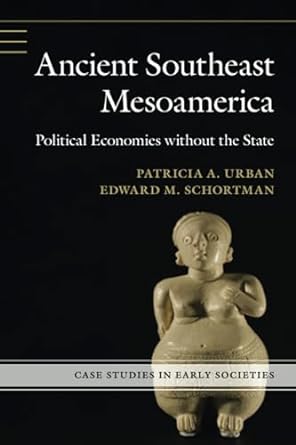Ancient Southeast Mesoamerica
political economies without the state
- ISBN: 9781316624890
- Editorial: Cambridge University Press
- Fecha de la edición: 2024
- Lugar de la edición: Cambridge . Reino Unido
- Colección: Case Studies in Early Societies
- Encuadernación: Rústica
- Medidas: 24 cm
- Nº Pág.: 410
- Idiomas: Inglés

Ancient Southeast Mesoamerica explores the distinctive development and political history of the region from its earliest inhabitants up to the Spanish conquest. It was composed of a matrix of social networks rather than divided by distinct cultures and domains. Making use of the area's rich archaeological data, Edward Schortman and Patricia Urban provide a social network analysis of southeast Mesoamerica. They demonstrate how inhabitants from different locales were organized within such networks, and how they mobilized the assets that they needed to define and achieve their own goals. The also provide evidence for the actions of other groups, who sought to promote their importance at local and regional scales, and often opposed those efforts. Schortman and Urban's study demonstrates the fresh insights gained from study of socio-political structures via a social network perspective. It also challenges models that privilege the influence of powerful leaders in shaping those structures.
1. Ways of understanding Southeast Mesoamerica; 2. Power, hierarchy, and social differentiation; 3. Early arrivals, domestication, and emerging sociopolitical complexity in Southeast Mesoamerica (10,000 (?) – 400 BCE); 4. Reformulating social networks through the novel uses of things (400 BCE – CE200); 5. The arrival of divine lords: early classic Southeast Mesoamerica (CE 200 – 600); 6. The Copán realm, its colonies and allies (CE 600–800); 7. The end of days: political decentralization and its aftermath among Members of the Copán-centered network (CE 820–1000); 8. Concentrating power and building hierarchy beyond the Copán-centered network (CE 600–800); 9. Concentrating power in the terminal classic beyond Copán (CE 800–1000); 10. Power and political economy in the late classic Naco and Middle Chamelecón Valleys (CE 600–800); 11. Hierarchy to heterarchy in the terminal classic Naco and Middle Chamelecón Valleys (CE 800–1000); 12. Contrasting forms of complexity: the postclassic (CE 1000–1550) in Southeast Mesoamerica; 13. Contesting for power, challenging hierarchy, making history.






